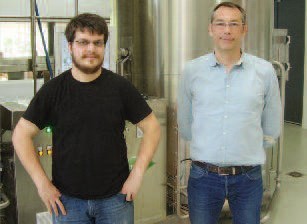Purity

The beer is available on tap or can be taken away
in bottles or in recyclable stainless steel casks.
Ingredients
Water quality is a large determinant in brewing, and thankfully the water of Burgundy is exceptionally pure. However, it is rich in calcium, which is filtered out by osmosis in order to prevent the fermentation from occurring too quickly and subtracting from the roundness of the taste. The malt can be roasted at different temperatures and for different durations to achieve tastes varying from coffeelike bitterness to caramel and chocolate. The “coffee” flavour that I sampled had an agreeable taste. The taste of beer is also influenced by the hops, whose bitter taste balances the sweetness of malt. Hops come in several varieties – apparently there are around 600 different types – and at least two kinds are used in every beer.
They are added in two instalments during the boiling process: first to add bitterness, then (two minutes before the end) to add aroma. Before being added to the beer it is crushed into a paste of almond green colour. I was offered a taste – very good for the health apparently – and it reminded of that bitter, gaseous smell which clings to taverns the morning after beer has been drunk. And that was a mild variety! Romain tells me there are around 3,000 different types of beer, and that several more types could be invented simply through permutation of the basic ingredients in various ways. However good the beer, the commercial fortune of all breweries fluctuates heavily according to weather conditions. For Marc and Romaine’s sake we most hope for a hot summer, in which they will see many visitors flock to their brewery on banks of the quiet river Cure to sample their fine products.

Mash and wart kettle, with computer console in the foreground
The brewery process
The resultant mash is transferred to the lauter tun (top right-hand), where the grain is filtered out. The resultant paste, called “wort”, is then transferred back to the left-hand tank, where it is boiled while hops are added. The liquid then flows to the whirlpool (bottom right), where any remain solids are eliminated by centrifugal spinning. After the wort has cooled, it is transferred to a fermentation tank, where yeast is added so that fermentation can occur (photo 3). Fermentation lasts five to seven days, after which further time is required for the liquid to settle and clear (lagering).

Fermentation tanks.
Stainless steel is used throughout the process, starting with the crusher and continuing with the two brewing tanks and the fermentation tanks. Some of the fermentation tanks have an easy recognizable form, being cylindrical on the top and coned at the bottom. Finally, even the bottling machine is constructed of stainless steel. The conditions in a brewery are a combination of heat and corrosion. Other reasons for using stainless steel include taste (the taste of the various different kinds of beer will not permeate the material) and hygiene (the smooth surfaces can easily be washed). All tanks are made of an interior and an exterior layer. For the interior, stainless steel is required. Exteriors can use other materials (such as copper), though it happens that the exterior cladding used at Brasserie de Vézelay is also stainless. The equipment is supplied by Kaspar- Schulz, Bamberg, Germany. Most of the equipment, including the fermenters, is made from 1.4301 (304), but 1.4571 (316Ti) is used for the high-temperature applications (1).

Marc Neyret (left) and Romain Flesch
(right).
In the background, the lauter tun
and whirlpool.


